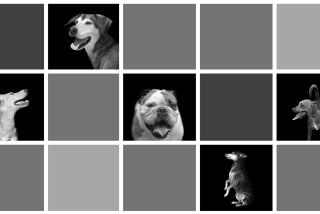Tale of a dog, a parasite and two women

- Share via
This is the story of a dog-ophobe, a dog-ophile and the parasite that brought them together. The dog-ophobe (for want of a better word) is a patient. The dog-ophile is her doctor -- me.
My story is simple. At the end of the day, I look forward to two spaniels at home more than I do comfort food. Their wags are my Prozac, their snores my lullaby. So now you know where they sleep. Not under the bedcovers, but close.
By coincidence, my work also involves animals, but with a twist. I’m an expert in the parasites they occasionally transmit to humans.
Which leads me to my patient, a charming person who exudes kindness toward all creatures great and small. Here in dog-struck Los Angeles, I could easily picture her with an equally charming pooch. There’s just one catch. For as long as she can remember, she has deeply distrusted dogs.
To explain why is to tell a tale both earthy and sad: of her lifelong battle with a tapeworm that once lived in a dog’s intestine. That dog excreted a microscopic egg that my patient, as a child, unknowingly swallowed. That egg released a larva that entered her liver and slowly grew -- and grew -- and grew.
Several decades later, my patient underwent a liver transplant, her ultimate standoff against a canine parasite that spawns generation upon generation of bubble-like cysts in human organs -- livers in particular.
My patient is far from alone in suffering this blight, of course. More than 1 million people worldwide -- most of whom can barely imagine the high-tech medical care she has received -- harbor the same invader. The majority live in remote places where dogs and sheep (the animals from which dogs acquire the tapeworms) are in close contact.
During my career in Los Angeles, I’ve seen roughly two dozen people with Echinococcus granulosus, all of whom contracted their infection years to decades before immigrating to the United States. Some I’ve treated with pills, some I’ve referred for surgical procedures. But none of these sufferers required a liver transplant.
A huge, Y-shaped abdominal scar and a medicine cabinet lined with anti-rejection drugs are daily reminders of my patient’s long-ago “gift” from man’s best friend. As for the creature that launched her fate, she never knew its face or eyes or bark. But she does know when they met.
The year was 1942, the place Palestine. Conditions in the then-British protectorate were harsh save one virtue: It was far from the Holocaust. But along with my patient’s security came her medical fate: a mote of Middle East dust ferrying a tiny egg.
Once my patient’s parents learned of her diagnosis, they never forgot its source -- Dogs, with a capital D. “Don’t touch them -- they’re dirty!” is a phrase that rings in her ears to this day. Thus was born an aversion she’s never shaken.
Back to the present. Almost a lifetime after a little girl contracted a weird blight in a far-away land, where do I fit in, especially now that she has a new, parasite-free liver?
That’s the irony. Although a liver transplant saved my patient’s life, it did not rid her of echinococcosis. Quite the opposite: The immunosuppressant drugs she must down for the rest of her days actually nurture larval cysts in other parts of her body. So along with a fistful of other medications, she takes one more daily pill to hold them at bay.
I oversee that treatment and pay special attention to her lungs, which currently house two parasite growths the size of tangerines. Fortunately, according to my patient’s recent CT scans, they’re stable.
We still meet regularly, however -- to renew her prescriptions, discuss her general health, catch up with each other’s lives. The truth is, we just plain like each other. Sometimes I call her out of the blue to see how she’s doing. She and her husband have, in turn, invited my husband and me to Passover dinner. This year’s date is already in our calendar.
If you met my patient casually (say in a store or at a party), you would never guess the tough hand life has dealt her. She works. She travels. She goes to the gym. And she is a beloved wife, mother and friend. In short, like many who have battled long and hard against a daunting foe, she has risen to higher ground, always accentuating the positive to the best of her ability.
There’s just one chink in her armor. As she confessed to me not long ago: She can’t fool dogs. If she meets even a 3-pound Chihuahua, no matter how hard she tries to check her body language, the animal senses her misgivings and steers clear. If dogs were gypsies or tramps, they would mark her door with a special sign: “Move on, perritos -- this one isn’t buying.”
Claire Panosian Dunavan is a professor of medicine and infectious diseases at the David Geffen School of Medicine at UCLA.
Are you a doctor, nurse or someone else working in the health/medical field? Let us know if you have a story to tell or point of view to share about your work and the lessons you’ve learned from it. Submissions should be 750 words or fewer.






